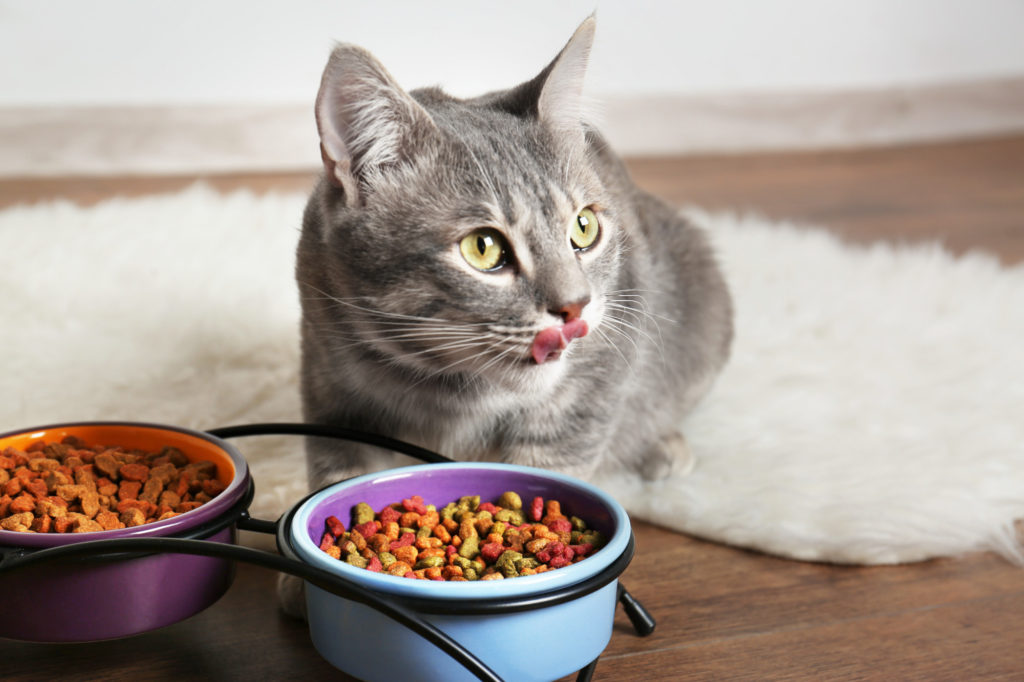
Is Mr. Kittles getting a little round?
Does the phrase “here, kitty, kitty” always lead him to the kitchen?
Is his begging getting out of control?
Then you may be feeding your cat too much or your cat maybe lacking in vitamins. To make sure your cat is getting the proper vitamins you can look into getting nutritional supplements for cats. Believe it or not, but feeding a cat too much create behavioral issues like begging. It can also be detrimental to their health.
So, how much should a cat eat?
You may feel like you know exactly how much your cat should eat. But, many pet owners overfeed or underfeed without being aware of it. They assume that they’re feeding them the right amount simply because they’ve done it for years.
But, poor cat nutrition can lead to a host of health problems. And, as we all know, health problems usually means a hefty vet bill. As well as time and energy spent getting them to a healthier state.
We, humans, struggle to eat the right foods, too. So, it’s no wonder that we’re also in the dark about our cats’ nutrition. And, that we indulge our kitties with treats the same way we do ourselves.
Read on to find out exactly how much food you should feed your cat.
How Much Should a Cat Eat?: Everything You Need to Know
This guide will give you all the answers to your cat diet questions. Explore the following information to answer the question, “how much should a cat eat?”
Assessing Your Kitty
Before you can determine how much to feed your cat, you need to examine them. Assess your kitty’s body to determine if they are currently over or underweight. If they are within a healthy range, then it’s likely that you’re feeding them the right amount.
First, feel for your cat’s ribs. If you can’t feel them then your cat is overweight. You’re feeding your cat too much and will need to adjust their portions or the number of times you’re feeding them.
On the other hand, if your cat’s backbone and ribs are visible, then you’re feeding too little. You’ll need to increase your cat’s caloric intake and/or offer free feeding throughout the day.
Correcting a thin cat’s diet is easier than adjusting an overweight cat’s diet. Speak with your vet before you change their diet, however. Doing so will rule out any possible health disorders.
Learn more about health disorders such as pancreatitis to know the symptoms to look for.
If you notice any negative changes in health or mood after changing their diet, you should contact your vet again.
Your Cat’s Needs
On average, an active eight-pound cat needs 240 calories per day. This equates to around 30 calories per pound for an active cat. Less active cats may require around 24 calories per pound.
These numbers aren’t the end all be all, however. Have your vet get a body condition score. Doing so will get your cat closer to a normal weight and diet that meets their needs.
Other factors that can influence a cat’s caloric intake include their age, metabolism, and whether your cat is nursing or pregnant.
Dry Food Vs. Wet Food
Dry food has different nutritional values than wet food. The brand you choose of each product will also affect how much you should feed your cat. Low-quality brands have less nutritional value, which requires larger portions.
High-quality dry food with natural ingredients and a low amount of fillers, for example, can meet all of your cat’s nutritional needs.
But, it’s recommended to also feed your cat canned food. This is because cats don’t drink water like dogs.
Instead, they get most of their water from their food. So, if your cat has a UTI, then only feeding them dry food is likely the cause. Have multiple sources of water around your home to also prevent health issues.
If you do decide to only feed them dry-food, then you’ll need to also provide your cat with constant access to water. To encourage them to drink the water, crush up a couple of catnip leaves into their water.
They can’t resist!
If you decide to feed your cat both dry and wet food, always keep in mind quality and caloric limits. Measure out both the wet and dry foods in advance to avoid over or underfeeding.
Lastly, know that your cat can never follow the path of becoming a vegetarian or vegan. Your cat will always be a carnivore and needs meat-based items to receive adequate nutrition. Substitute products are available, but may not be a good choice for your cat’s needs.
How Often to Feed Your Cat
As long as your cat is receiving adequate nutrition, you can adjust their feeding schedule. Many cat owners feed their cats in the morning and at night.
Other cat owners allow their cats to free-feed throughout the day. If you choose this feeding schedule, then always pre-measure.
If you’re bringing home a cat that is already used to a feeding schedule, then stick to it. Stick with this schedule until your new kitty is used to her new environment. Otherwise, your cat could experience health problems that could affect her weight.
Monitoring Your Cat’s Condition
Continue to monitor your cat’s body and its condition every two weeks. Especially, if you changed their diet. Do a rib/backbone check and re-adjust their servings as needed.
Monitor their behavior and activity levels. If any negative changes occur such as fatigue, contact your vet.
Once, your cat reaches an ideal range, weigh her one time per month.
How Much Should a Cat Eat?: It Depends!
Understanding that there is no one-size-fits-all answer to the question, “how much should a cat eat?” is vital to your cat’s health. Cat’s dietary needs depend on many different factors such as their breed and preferences.
To get an individualized answer, contact your vet. If your cat refuses to eat certain types of food, then speak with your vet about finding an alternative source. If your cat is currently over or underweight, then you should also speak with your vet about how to fix this issue.
Interested in learning more about cats? Keep reading our blogs.







Speak Your Mind